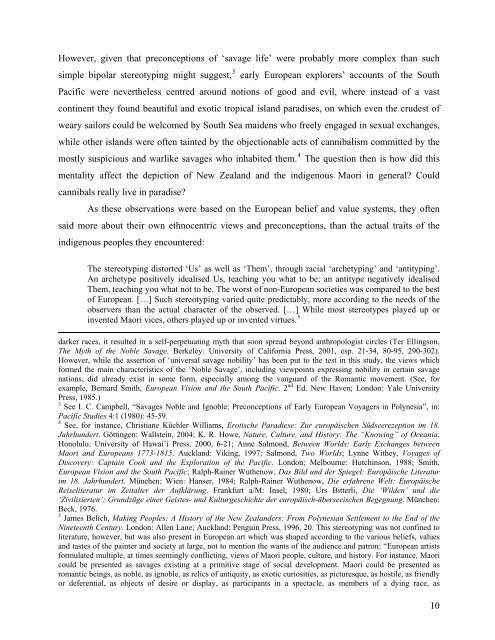General copyright and disclaimer - ResearchSpace@Auckland ...
General copyright and disclaimer - ResearchSpace@Auckland ...
General copyright and disclaimer - ResearchSpace@Auckland ...
Create successful ePaper yourself
Turn your PDF publications into a flip-book with our unique Google optimized e-Paper software.
However, given that preconceptions of ‘savage life’ were probably more complex than such<br />
simple bipolar stereotyping might suggest, 3 early European explorers’ accounts of the South<br />
Pacific were nevertheless centred around notions of good <strong>and</strong> evil, where instead of a vast<br />
continent they found beautiful <strong>and</strong> exotic tropical isl<strong>and</strong> paradises, on which even the crudest of<br />
weary sailors could be welcomed by South Sea maidens who freely engaged in sexual exchanges,<br />
while other isl<strong>and</strong>s were often tainted by the objectionable acts of cannibalism committed by the<br />
mostly suspicious <strong>and</strong> warlike savages who inhabited them. 4 The question then is how did this<br />
mentality affect the depiction of New Zeal<strong>and</strong> <strong>and</strong> the indigenous Maori in general? Could<br />
cannibals really live in paradise?<br />
As these observations were based on the European belief <strong>and</strong> value systems, they often<br />
said more about their own ethnocentric views <strong>and</strong> preconceptions, than the actual traits of the<br />
indigenous peoples they encountered:<br />
The stereotyping distorted ‘Us’ as well as ‘Them’, through racial ‘archetyping’ <strong>and</strong> ‘antityping’.<br />
An archetype positively idealised Us, teaching you what to be; an antitype negatively idealised<br />
Them, teaching you what not to be. The worst of non-European societies was compared to the best<br />
of European. […] Such stereotyping varied quite predictably, more according to the needs of the<br />
observers than the actual character of the observed. […] While most stereotypes played up or<br />
invented Maori vices, others played up or invented virtues. 5<br />
darker races, it resulted in a self-perpetuating myth that soon spread beyond anthropologist circles (Ter Ellingson,<br />
The Myth of the Noble Savage. Berkeley: University of California Press, 2001, esp. 21-34, 80-95, 290-302).<br />
However, while the assertion of ‘universal savage nobility’ has been put to the test in this study, the views which<br />
formed the main characteristics of the ‘Noble Savage’, including viewpoints expressing nobility in certain savage<br />
nations, did already exist in some form, especially among the vanguard of the Romantic movement. (See, for<br />
example, Bernard Smith, European Vision <strong>and</strong> the South Pacific. 2 nd Ed. New Haven; London: Yale University<br />
Press, 1985.)<br />
3<br />
See I. C. Campbell, “Savages Noble <strong>and</strong> Ignoble: Preconceptions of Early European Voyagers in Polynesia”, in:<br />
Pacific Studies 4:1 (1980): 45-59.<br />
4<br />
See, for instance, Christiane Küchler Williams, Erotische Paradiese: Zur europäischen Südseerezeption im 18.<br />
Jahrhundert. Göttingen: Wallstein, 2004; K. R. Howe, Nature, Culture, <strong>and</strong> History: The “Knowing” of Oceania.<br />
Honolulu: University of Hawai’i Press, 2000, 6-21; Anne Salmond, Between Worlds: Early Exchanges between<br />
Maori <strong>and</strong> Europeans 1773-1815. Auckl<strong>and</strong>: Viking, 1997; Salmond, Two Worlds; Lynne Withey, Voyages of<br />
Discovery: Captain Cook <strong>and</strong> the Exploration of the Pacific. London; Melbourne: Hutchinson, 1988; Smith,<br />
European Vision <strong>and</strong> the South Pacific; Ralph-Rainer Wuthenow, Das Bild und der Spiegel: Europäische Literatur<br />
im 18. Jahrhundert. München; Wien: Hanser, 1984; Ralph-Rainer Wuthenow, Die erfahrene Welt: Europäische<br />
Reiseliteratur im Zeitalter der Aufklärung. Frankfurt a/M: Insel, 1980; Urs Bitterli, Die ‘Wilden’ und die<br />
‘Zivilisierten’: Grundzüge einer Geistes- und Kulturgeschichte der europäisch-überseeischen Begegnung. München:<br />
Beck, 1976.<br />
5<br />
James Belich, Making Peoples: A History of the New Zeal<strong>and</strong>ers: From Polynesian Settlement to the End of the<br />
Nineteenth Century. London: Allen Lane; Auckl<strong>and</strong>: Penguin Press, 1996, 20. This stereotyping was not confined to<br />
literature, however, but was also present in European art which was shaped according to the various beliefs, values<br />
<strong>and</strong> tastes of the painter <strong>and</strong> society at large, not to mention the wants of the audience <strong>and</strong> patron: “European artists<br />
formulated multiple, at times seemingly conflicting, views of Maori people, culture, <strong>and</strong> history. For instance, Maori<br />
could be presented as savages existing at a primitive stage of social development. Maori could be presented as<br />
romantic beings, as noble, as ignoble, as relics of antiquity, as exotic curiosities, as picturesque, as hostile, as friendly<br />
or deferential, as objects of desire or display, as participants in a spectacle, as members of a dying race, as<br />
10















